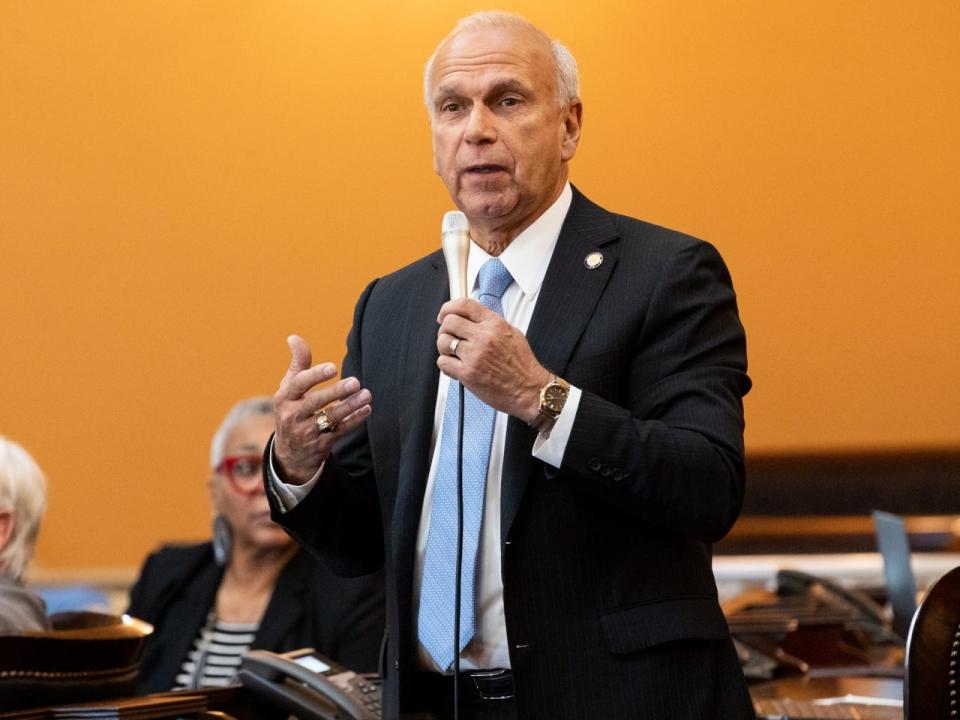Senate Bill 83 'firestorm' clouds fact that it will rein in college tuition costs| Cirino

- Oops!Something went wrong.Please try again later.
Ohio State Senate Jerry C. Cirino (R-Kirtland) introduced Senate Bill 83, the Ohio Higher Education Enhancement Act.
I sparked a firestorm when I introduced Senate Bill 83, the Ohio Higher Education Enhancement Act — but the uproar is over an issue that’s not really controversial.
The main criticism, that it will curtail free speech on campus, is just plain wrong. It is factually incorrect.
Jerry Cirino: Ignore 'hysteria.' Freedoms attack on Ohio campuses. My bill will protect them
Opinion: Ohio lawmakers hostile to colleges, universities. Politically motivated plot proof
Senate Bill 83 is specifically designed to protect free speech on campus.
It will not ban any courses, subjects, or topics of discussion. It will simply guarantee the right of students and professors to speak their minds without fear of retribution.

Tuition cost out of control in Ohio.
However, this tempest in a teapot has obscured another provision of the bill I had thought would spark much more interest — our effort to rein in runaway tuition costs at institutions of higher education.
Senate Bill 83 does that by requiring financial transparency and accountability.
More: Ohio Senate passes SB 83, controversial higher education bill. What would it do?
Our view: Anti-American bills will enslave minds of Ohio students
This is a timely issue not just because so many students across America are returning to campus after another round of tuition hikes; the Wall Street Journal has just published a pair of articles that show there are few controls over lavish spending by universities, and next to no accountability or transparency in their finances.
The paper found that some of the most expensive public universities, with some of the largest tuition increases, are experiencing some of the worst financial difficulties.
They have gone on spending sprees with little oversight and are passing much of the costs onto students, which is fueling the nation’s $1.6 trillion federal student debt crisis.
The Journal reported, "student loans served as easy financing for university projects." And, "tuition and fee revenue per student climbed by double digits in the past 20 years at every school."
The paper tried to track down the root cause of the problem by examining "financial statements since 2002 from 50 universities known as flagships" but ran into a brick wall.
More: Jerry Cirino's SB 83 is a union-busting effort that will severely damage higher ed in Ohio
Where did the money go?
Into a black hole.
"Trustees demanded little accountability and often rubber-stamped what came before them. And schools inconsistently disclose what they spend, making it nearly impossible for the public to review how their tuition and tax dollars are being used."
Compounding the problem, "public-university trustees approved 98% of the cost-increasing proposals they reviewed, often unanimously.” A follow-up article said, "A number of university trustees, faculty and staff members are calling for more transparent financial data."
That's exactly what Senate Bill 83 does. It provides transparency and accountability for higher education spending in Ohio.
How Senate Bill 83 would make universities accountable.
The bill requires the chancellor and Ohio’s institutions of higher education to develop a standardized format for reporting financial expenses.
Those institutions must prepare five-year summaries of costs, which the chancellor will then submit to the general assembly when considering our biennial operating and capital budgets.
The summaries must report all costs, including salaries, benefits, food service, healthcare, maintenance, housing management, counseling, and financial aid assistance.
The chancellor will have the opportunity to detail and explain the costs to the relevant committees considering budget requests.
Ohio’s institutions of higher learning also will be required to provide a detailed breakdown of all costs annually, including a list of all employees.
The Dispatch reported just last month that Ohio State announced a “3% increase (that) will cost Ohio residents about $12,859 a year for tuition and fees, a change of about $374. That does not include housing and dining costs or additional fees related to specific majors.”
More: Ohio State trustees to meet Friday to raise tuition and fees for incoming freshmen class
The best way to prevent skyrocketing tuition costs is to learn where all that money is actually going and whether it is being used effectively. To do that, we need to clear up the cloudy financial reporting and provide clarity on spending in plain language.
Professor: Admitting “white privilege” shouldn't be required at Ohio universities
More: Bill is 'a dumpster fire' that threatens to incinerate free speech' at Ohio's colleges| Opinion
That will help ensure our students get the best education possible and give them and their parents the security of knowing it will be money well spent.
Ohio State Senate Jerry C. Cirino (R-Kirtland) introduced Senate Bill 83, the Ohio Higher Education Enhancement Act.
This article originally appeared on The Columbus Dispatch: Senate Bill 83 uproar hides that it will rein in college costs, senator

